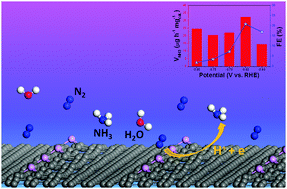P-Doped graphene toward enhanced electrocatalytic N2 reduction†
Abstract
Catalysts for the N2 reduction reaction (NRR) are at the heart of key alternative technology to the Haber–Bosch process for NH3 synthesis, and are expected to optimize the interplay between efficiency, activity and selectivity. Here, we report our recent finding that P-doped graphene shows superior NRR performances in aqueous media at present, with a remarkably large NH3 yield of 32.33 μg h−1 mgcat.−1 and a high faradaic efficiency of 20.82% at −0.65 V vs. reversible hydrogen electrode. The mechanism is clarified by density functional theory calculations.



 Please wait while we load your content...
Please wait while we load your content...